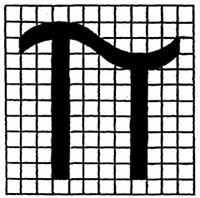Conformity of gas cylinders
Gas cylinders must be designed, produced, inspected and tested in accordance with the relevant standards. In Finland, the material must be able to withstand temperatures down to -40°C.
For an example of the TDG markings of gas cylinders, see the packing and marking examples
Scuba tanks and other oxygen tanks are subject to the requirements of the Pressure Equipment Act. More information
Gas cylinder certification marks
In Finland, you can tell a certified gas cylinder by the certification mark and a valid periodic inspection stamp. There are different certification marks depending on the gas cylinder’s age and purpose of use. Normally, the certification marks are located on the shoulder of the valve-end of the gas cylinder.

The figure shows the location of the certification mark on the shoulder of the gas cylinder.
Finnish gas cylinders
A gas cylinder certification mark should include a stamped “pi” sign (π) in accordance with the EU Directive on Transportable Pressure Equipment (2010/35/EU) and the ID number of the inspection body. The Directive on Transportable Pressure Equipment has been mandatory for new gas cylinders as of 1 July 2001. Older cylinders must be equipped with markings in accordance with the previously valid national Finnish certification system and the “pi” sign is not required. The marking in accordance with the national Finnish certificate comprises the certification number of the gas cylinder’s structural plan (such as “1234-85”) and the structural inspection stamp: the ID of the authority or inspection body, the inspector's mark and the time of the structural inspection: year-month.
Foreign gas cylinders
Finland has also approved the use of foreign gas cylinders provided that the gas cylinder compliance assessments, compliance reassessments, periodic inspections and other measures to demonstrated compliance have been performed (Directive on Transportable Pressure Equipment (2010/35/EU)). In accordance with the directive, such gas cylinders are marked with the π sign, i.e. letter “pi” in the Greek alphabet, and the cylinders also show the ID number of the body that conducted the initial inspections and tests.

Figure: the “pi” sign (the grid is for illustration only; it is not part of the sign)
The stamped markings on gas cylinders approved for international transport use beyond the EEA include the UN identifier for pressure vessels (the letters U and N inside a circle, the so-called UN packaging identifier). Although a cylinder like this without the “pi” sign is meant for international gas transport, it can also be used in Finland the same way as a cylinder marked with the “pi” sign.

Figure: UN packaging identifier
-40°C resistance requirement for to gas cylinders
When selecting a metal for the manufacture of an over 1-litre pressure vessel and to ensure the weldability as well as the durability of the welding, the durability of the material against brittle fracture up to a temperature of -40ºC must be taken into account, unless a lower temperature has been specified for materials belonging to a different class, the metal in question or pressure vessels. After the ID number of the inspection body, the pressure vessel must display the “-40°C” marking indicating the resistance of the material, unless the resistance is otherwise indicated on the container or by some other marking approved by Tukes. In other words, pressure vessels of a maximum capacity of 1 L do not have to meet the national material resistance requirement of -40°C.
How can you identify a non-compliant gas cylinder?
A non-compliant gas cylinder is missing the “pi” sign, national certification or UN mark indicating compliance. Other compliance certificates granted outside Finland and the EU, such as the DOT certificate of the United States, are not approved indications of compliance in Finland. A gas cylinder like this may not be legally used in Finland.
For example, a gas cylinder with the American DOT certificate shows a stamped “DOT” (DOT = Department of Transportation) mark and the stamped pressure values are indicated in “psi” instead of “bar”.
Periodic gas cylinder inspection markings
In the periodic inspection of a gas cylinder, the inspection body stamps the cylinder with an inspection stamp. The periodic gas cylinder inspection stamp is comprised of the inspection body’s ID and the time of the periodic inspection: year-month. The cylinder should be equipped with a label indicating the year of the next periodic inspection.
Certification and inspections
The inspection bodies of transportable pressure equipment are so-called notified bodies. Inspection bodies that perform inspection body duties related to transportable pressure equipment are recognised, i.e. approved, by Traficom. In Finland, there are two types of notified bodies: type A and type B. In addition, there are inspection services operating under the supervision of type A notified bodies.
The duties of the different notified bodies:
- Notified type A inspection body:
- Approval of gas tanks
- Periodic gas tank inspections
- Approval of gas cylinders and vessels
- Periodic inspections of gas cylinders and vessels
- Notified type B inspection body:
- Periodic inspections of gas cylinders and vessels